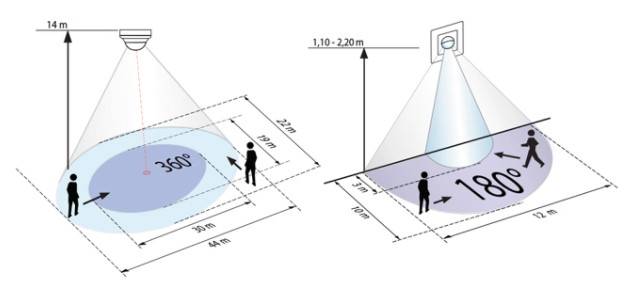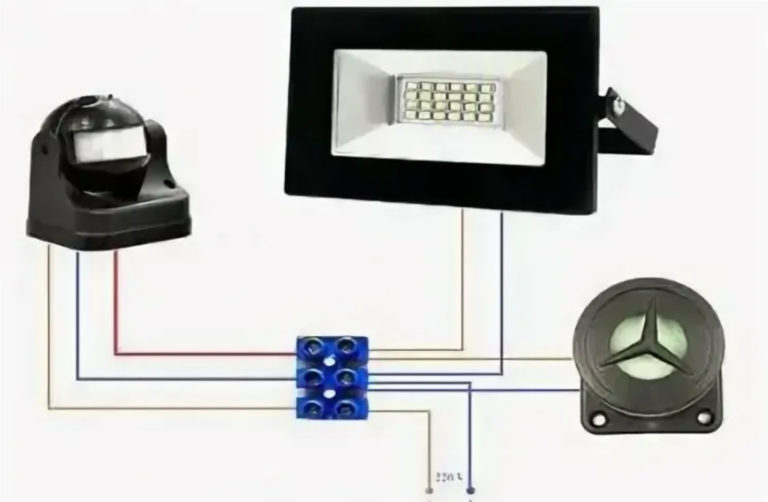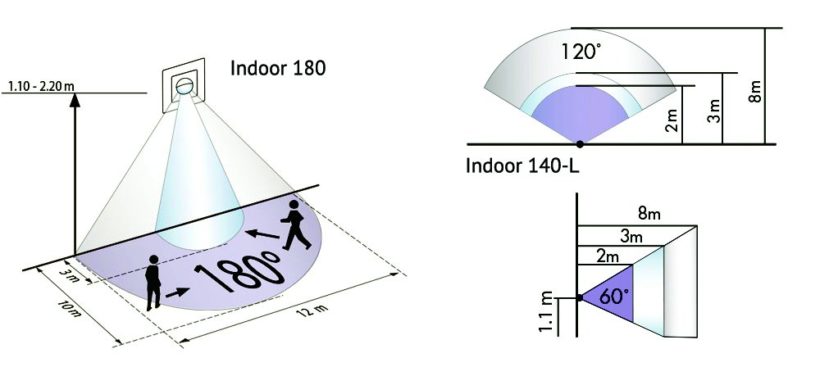How to adjust the motion sensor for lighting
Using a motion detector to turn on lights in many cases results in significant energy savings. The effect is achieved by turning on the light in the monitored area only when there are people or cars on it. Combining such a detector with a photo relay allows you to fully automate the control of lighting. If the detector does not have a built-in photo relay, you can buy it separately and connect the contacts in series with the contacts of the sensor. But to achieve the full effect, the sensor must be configured. Regardless of what principle of operation the detector has (infrared, radio frequency, ultrasonic), you can configure any motion detector yourself.

Characteristics determined by the manufacture of the sensor
Some of the characteristics are determined by the design of the sensor, and is not subject to adjustment. Therefore, it is advisable to determine some parameters before purchase. Such characteristics include:
- Viewing angle. Determined by the design of the sensor. Ceiling sensors usually have an angle of view of 360 degrees. Wall-mounted detectors, for obvious reasons, do not exceed 180 degrees.Viewing angle of wall and ceiling detectors
- Detection distance. Also depends on the design and the principle of operation of the sensor. Radiofrequency (microwave) detectors are the most long-range, but they also cost more. They are designed to control the warehouse and other similar premises. In an apartment or entryway, a cheaper infrared (at most, an ultrasonic) detector is enough.
- Load capacity. Determines how much light the sensor can control. Due to the general trend toward LED lighting, even a low-power contact group is enough to control a high-efficiency luminaire. But you must check the ability of the contacts to switch 220 volts.
Important! If the load capacity of the sensor output is not enough, the problem is easily circumvented by using an intermediate relay.

Parameters to be set
Another part of the sensor parameters can be adjusted to specific local conditions. This will help optimize the lighting system and minimize false positives.
- First, you choose the correct installation angle. This is adjusted so that the object is detected immediately upon entering the monitored area.Variants of correct and incorrect setting of the monitoring angle.
- Secondly, the sensitivity of the sensor is adjusted (the adjusting body is referred to as SENS from the word sensitive). The essence of this adjustment is to tune out from triggering when detecting objects of small size. In most cases, these are small animals, for them it does not make sense to turn on the light.
- Most sensors are equipped with a photocell. Without it, the sensor will also be triggered during daylight hours, or you will have to turn them off manually. The photocell threshold must be adjusted so that the detector will not allow the power to be consumed during the day, but will turn on the lights at night in time. The control is labeled LUX or Day Light.
- Many models have the ability to set a time delay off. This is convenient when leaving the territory - the light will not turn off immediately, allowing the person or car to move away not in complete darkness.
Not all detectors have a complete set of settings. Some inexpensive models may not have a response time setting, others may not have sensitivity to the size of objects.

Setting up a motion detector in a room
Regardless of the location of the sensors, before setting up the system, you should carefully study the manufacturer's instructions and their recommendations for adjustment.
The peculiarities of the sensor setting in the room are that it requires more illumination for work or life. For example, in corridors the illumination should be not less than 600 lux, and in the working rooms not less than 1000 lux. The initial installation can be guided by these figures. The switching threshold should be higher - darkness indoors comes earlier than outdoors.
Adjusting the outdoor sensor
Outdoors, you can leave the lights off until deep darkness. And the light level can be lower. So, in parking lots, in passageway areas you can be guided by the figure of 150...300 lux. But the sensitivity should be loaded. The probability of small animals, large insects, objects driven by the wind on the street is much higher.
Adjusting sensor parameters
Not all sensors have full-featured adjustment of all three main parameters, but the adjustment technique does not depend on the number of adjusters. Each parameter is adjusted individually.
- Threshold level of illumination. To set it, you must set the maximum sensitivity of the photo relay and wait in the evening for the level of light at which it is desirable to turn on the light. In the morning you can check at what light level the lamps will turn off.
- Adjustment of the motion sensor consists of sensitivity selection. It is possible to set the adjusting organ to the state of least sensitivity, ask the assistant to enter the monitored area and stop at its boundary. If the detector does not work, you should increase the sensitivity until a signal is given, and after that turn the knob a little more towards increasing. This is to ensure that the detector responds reliably to the appearance of people with different anthropological parameters. If the detector works immediately, you should try to decrease the sensitivity until the signal disappears, and then also turn the knob a little further in the direction of triggering. It should be taken into account that sensitivity of sensors depends on the direction of movement - along the controlled zone or across (in the direction of the luminaire).Sensitivity zones for longitudinal and transverse movement.
- The delay time can be set at first to zero or a few seconds, and in the process of operation to increase to the desired value. Or you can make an experiment with the assistant leaving the monitored zone and set the approximate release time.
If the selected detector does not have any of the adjustments, the corresponding item can be skipped. For example, in low-cost models of IR sensors manufactured by Legrand, sensitivity adjustment (SENS) is not provided. Only the light threshold and release time can be adjusted. Only the more advanced products have SENS adjustment.
| Motion detector | Adjustment of parameter | ||
| LUX | SENS | TIME | |
| Legrand PIR IP55 | x | - | x |
| Legrand Ceiling 360° | x | - | x |
| Legrand Mosaic | x | x | x |
| Legrand Valena (ultrasonic) | x | x | x |
And detectors manufactured by Xiaomi have not only a full range of settings (software way), but also the ability to set scenarios that significantly increases the comfort of using the devices.

Checking the correctness of the adjustment
To check the correctness of the adjustment can only be in the operating conditions, and this process can take more than one day. The first time you need to carefully monitor the sensor and adjust the setting and location of the detector.
- If the photocell of the detector turns on before darkness is reached or does not turn off when the desired light level is reached in the morning, its sensitivity to lightness (LUX) should be slightly adjusted. And vice versa, if it is already dark and the light does not turn on when the object appears, you should slightly increase the evening threshold for the photo relay. It is also good to see the triggering in the morning. The switch-on and switch-off thresholds are slightly off, this is done to avoid repeated triggering of the sensor at the edge of light and dark (the characteristic has hysteresis). Therefore, it may take several days to reach a compromise result.
- The same applies to the sensitivity of the sensor. If you often see false alarms caused by small animals, you can reduce the sensitivity by turning the Sens knob. If you notice an unstable triggering of people in the coverage area, you should increase the sensitivity.
- The Time setting can be initially set to minimum. If it is noticed during operation that people or cars do not have time to leave the monitored area, the response time can be gradually adjusted upwards until the desired result is achieved.
The adjustment may take a long time, but it is worth the expense.
Video tutorial on how to configure the sensor.
How to avoid false alarms
First of all, false alarms can be eliminated by careful adjustment of the motion sensor. But this is not always sufficient. False alarms of the infrared sensor can be caused by an irregular heat source (chimney, air conditioner) or a light source (headlights of passing cars) entering the field of view of the sensor. When adjusting the sensitivity to small objects, the angular size of the light spot may be sufficient for false triggering if animals will be in the immediate vicinity of the detector. Therefore, it is necessary to install the sensor in places where the appearance of animals is excluded. Also unauthorized triggers can be caused by:
- Battery discharge in wireless sensors;
- Bad contacts in the connecting line from the detector to the executive module;
- unstable contact of micro-switches, which protect the sensors from tampering by intruders.
Avoid these situations by regular monitoring of the state of the system and timely troubleshooting. But it is unlikely to completely avoid interference.

Thus, it is impossible to foresee insects crawling on the surface of the street sensor and other unpredictable situations. But it is quite realistic to reduce false activations by adjusting and selecting the position of the sensor to a minimum.





